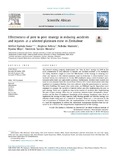Please use this identifier to cite or link to this item:
https://cris.library.msu.ac.zw//handle/11408/4103Full metadata record
| DC Field | Value | Language |
|---|---|---|
| dc.contributor.author | Nunu, Njabulo Wilfred | - |
| dc.contributor.author | Ndlovu, Brighton | - |
| dc.contributor.author | Mudonhi, Nicholas | - |
| dc.contributor.author | Moyo, Nyasha | - |
| dc.contributor.author | Murwira, Tinotenda Success | - |
| dc.date.accessioned | 2021-05-05T10:13:05Z | - |
| dc.date.available | 2021-05-05T10:13:05Z | - |
| dc.date.issued | 2021-07 | - |
| dc.identifier.issn | 24682276 | - |
| dc.identifier.uri | https://www.sciencedirect.com/science/article/pii/S2468227621000338 | - |
| dc.identifier.uri | http://hdl.handle.net/11408/4103 | - |
| dc.description.abstract | The selected mining company implemented the "Peer to Peer" strategy in 2008 to fast track achievement of zero tolerance to injuries and fatalities incidents at its workplace. Our study, therefore, sought to assess the effectiveness of this strategy in reducing accidents and injuries at this selected platinum mine in Zimbabwe. A mixed-method cross-sectional survey was conducted on 32-day shift employees using a semi-structured questionnaire with closed and open-ended questions. Furthermore, incident trend analysis was done on data obtained from the records from 2004 to 2017. Covert observations were then employed to triangulate findings from data collected using the questionnaire on practices. The tests Hotelling, Chi-square, time series plots, and Multiple Logistic Regressions were employed to compare the variables of interest before and after implementing the peer to peer strategy. There was a significant drop in the number of incidents after implementing the peer to peer strategy. There was no association between tested demographic characteristics and the level of employees' knowledge of the strategy. Employees were afraid to implement the strategy to their superiors fully. Findings pointed out that this strategy was effective despite being part of a cocktail of strategies. There was a vast decrease in the rate of occurrence of incidents after the implementation of this strategy. However, there is a need for engagement to address the subordinate management dynamics that was observed to be a threat in the comprehensive implementation of this strategy. | en_US |
| dc.language.iso | en | en_US |
| dc.publisher | Scientific African | en_US |
| dc.relation.ispartofseries | Vol.12; | - |
| dc.subject | Effectiveness | en_US |
| dc.subject | Incidents | en_US |
| dc.subject | Injuries | en_US |
| dc.subject | Fatalities | en_US |
| dc.subject | Peer to peer | en_US |
| dc.subject | Platinum Mine | en_US |
| dc.subject | Zimbabwe | en_US |
| dc.title | Effectiveness of peer to peer strategy in reducing accidents and injuries at a selected platinum mine in Zimbabwe | en_US |
| dc.type | Article | en_US |
| item.openairetype | Article | - |
| item.fulltext | With Fulltext | - |
| item.openairecristype | http://purl.org/coar/resource_type/c_18cf | - |
| item.cerifentitytype | Publications | - |
| item.languageiso639-1 | en | - |
| item.grantfulltext | open | - |
| Appears in Collections: | Research Papers | |
Page view(s)
192
checked on Nov 25, 2025
Download(s)
88
checked on Nov 25, 2025
Google ScholarTM
Check
Items in MSUIR are protected by copyright, with all rights reserved, unless otherwise indicated.




